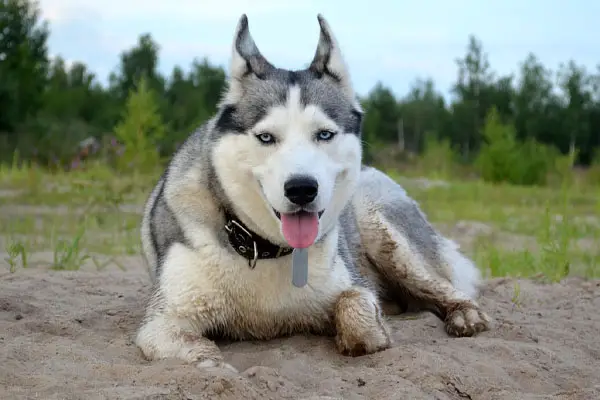Siberian Huskies are a medium-sized dog breed known for their beautiful wolf-like appearance. Most of the time, the Siberian Husky showcases adorable blue eyes that everyone loves. Their thick coat protects them in the cold and even harsh weather conditions.
They are known to be effortlessly powerful and have strong stamina to endure long miles of running even with little food intake. And since they grew up in packs, the same with wolves, they love being with a family and also with other dogs.

Siberian Husky Statistics
| Dog Breed Group | Working |
| Breed Size | Medium |
| Height | 21-23.5 inches (male); 20-22 inches (female) |
| Weight | 45-60 pounds (male); 35-50 pounds (female) |
| Lifespan | 12-14 years |
Siberian Husky Ratings
| Energy level | |
| Exercise needs | |
| Requires attention | |
| Playfulness | |
| Trainability | |
| Shedding | |
| Grooming | |
| Friendly with family | |
| Friendly with kids | |
| Friendly with strangers | |
| Friendly with other dogs | |
| Prey Drive |
Siberian Husky History
Although they look like wolves, Siberian Huskies didn’t come from the wolf lineage, nor are they a hybrid too. It is believed that they were originally bred by the Chukchi people, a tribe of Siberian nomads, about 4000 years ago or more.
The Siberian Huskies, known as the Chukchi dogs that time, were an all-purpose dog for the tribe. They were companion dogs for the tribe’s family – warming children when the weather is too cold. When the need arises, the dogs were used as endurance sled dogs so the tribe can transfer hunting grounds.
As the tribe was isolated from the rest of the world, they were able to keep the breed pure. This dog breed is said to be the direct line where the Siberian Huskies came from.
It was not until the 1900s when the dogs became popular and caught the eye of the Alaskan people. They were winning sled races and even assisted in saving a whole town from a deadly toxin by delivering a serum.
By 1930, Siberian Huskies were exported from Siberia, and their popularity continued to grow in North America. There might have been some slight changes form the Chukchi breed, but the essential and vital qualities remained.
Siberian Husky Temperament
Free-spirited is the best word to describe the Siberian Huskies. They are generally loyal, mischievous, and outgoing, as defined by the American Kennel Club.
Siberian Huskies are friendly with everyone – that includes strangers. They don’t easily get suspicious, aggressive, or protective as well, which is why they would be terrible guard dogs.
As pack dogs, they need someone to act as a leader. This makes them easy to train, especially if you establish superiority by giving consistent and clear rules. A great way to develop this is by making them wait to eat. Siberian Huskies can be pushy, and you shouldn’t give in.
Siberian Huskies are highly energetic and would need adequate exercise so they can expend it. If you cannot entertain them, they’ll get bored and might find their entertainment – which could be digging up holes in the garden or chewing valuable items.
On the bright side, they can be very playful. They love socializing and showing off their talents. They are also very loyal to their family, even to children.
When it comes to other dogs, they are very friendly. But the same cannot be said with cats as they might treat these as prey if it didn’t grow up with them. This is the same reason why rabbits and birds should not be kept with the Huskies.
Another thing that you might want to take note is that Huskies are not barkers; they’re howlers, which is even worse. They are very talkative and will answer back with a howl if given the opportunity. This makes Huskies not suitable in apartment buildings as it could cause a lot of complaints from neighbors.

Siberian Husky Care Requirements
- Nutrition: Siberian Huskies should be fed with high-quality food to maintain its healthy skin and coat. They are not large eaters, so it’s essential to have the right balance of proteins, fats, and carbohydrates. Siberian Huskies can be fed with raw food or commercial food. However, it’s not recommended to combine both as it will be hard for them to digest. For raw foods, your protein source can come from chicken, beef, lamb, or fish. You can add some vegetables and fruits too. If you want to save up, then commercial foods will be enough, but you need to make sure it’s of high quality. Monitoring is an essential part of feeding as well. Feel free to adjust the amount of their food intake if needed, but be careful not to overfeed.
- Grooming: The nice thing about Siberian Huskies is they can be self-cleaning, plus, they don’t have that dog smell. Generally, you might only need to give them a few baths in a year. To maintain their beautiful coat, regular brushing is needed. You can do this once a week or daily. Regular brushing will help prevent excessive shedding, which is very noticeable since their coat is usually colored white. Also, it will help prevent irritation. Check the nails and trim them as needed as well. If allowed to stay long, this could hurt your Husky and might cause foot problems.
- Exercise: Siberian Huskies are highly energetic dogs and would require daily exercise. At least one hour of running or walking in a day should suffice, but if you can do more, the better. You can also do some exercises that will challenge their minds as well. Generally, there are three main exercises that you would need to do: daily walk, high-intensity activity, and mental stimulation. Daily walks are essential and important not to miss. The length of your exercise will depend on your stamina walk because, honestly, Huskies don’t get tired and can walk all day long. For the high-intensity activity, you can do a flirt pole, fetch, jolly ball, frisbee, stair exercise, running or biking, tug of war, and more. There are a lot of ideas on the internet that you can search for and apply. Mental stimulation can be in the form of games such as puzzle games, scenting games, training, or chew toys. Again, you can get ideas from the internet. The only thing that you need to remember is that you should be consistent with this and make sure that your Husky doesn’t get bored. Also, do be careful with overexercising.
- Health: Siberian Huskies are generally healthy. There are no particular diseases that affect this dog breed in particular. But, they can be prone to minor health problems such as progressive renal atrophy (PRA), hypothyroidism, cataract, and corneal dystrophy.
- Lifespan: The life expectancy of Siberian Huskies is 12-14 years.
Siberian Husky Statistics
- Dog Breed Group: Working Group
- Height: 21-23.5 inches (male); 20-22 inches (female)
- Weight: 45-60 pounds (male); 35-50 pounds (female)
- Lifespan: 12-14 years

Famous Siberian Huskies
- Togo, Balto, and Fritz: Leaders of the “Great Race of Mercy” during a Diphtheria Outbreak in the town of Nome in Alaska; Bato lead the expedition of over 700 miles to deliver a life-saving serum; Fritz and Togo, half-brothers, lead important sections of the race too. However, Balto received most the credit for enduring the hardest leg of the race, when it was, in fact, Togo.
- Charlie: He pulled a 3,142-pound sled and was awarded as the strongest dog alive in 1963
- Droopy: Dropped out of the harness and fell out of sight during an exploration of Pourquois Pas in the 70s; He was found by his owner, Pawley, preserving himself by spreading all four paws and straddling the crevasse
- Mukluk: A Husky Mascot for Project Iceworm in 1960
Fun Facts About Siberian Huskies
- Siberian Huskies were born to run; they are believed to be the closest breed to the original Chukchi dogs, the ideal sled dogs.
- Siberian Huskies dominated the racing competitions in Alaska from 1909 to the following decades.
- Siberian Huskies have a lot of ways to keep warm; they have a thick double coat, their eyes allow them to squint out the snow, and they wrap their tails around faces while they sleep.
- A group of Huskies saved the children of Nome from death in 1905 by delivering an anti-toxin located 1000 miles away,
- They don’t get tired quickly, even if running long distances while having eaten so little.
- They were used as search and rescue dogs during WWII.
- Siberian Huskies’ howls can be heard up to 10 miles away.
- They are one of the top closest breeds to a wolf.
